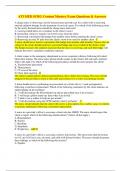Exam (elaborations)
2024 ATI MED SURG Content Mastery Exam Questions & Answers
- Course
- Institution
2024 ATI MED SURG Content Mastery Exam Questions & Answers-A charge nurse is observing a newly licensed nurse provide care for a client who is receiving internal radiation therapy for the treatment of cervical cancer. For which of the following actions by the newly licensed nurse should the charge ...
[Show more]



